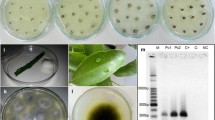Abstract
To improve mango anthracnose management in Taiwan, the critical timing when anthracnose invades mango panicles is a priority subject. A 3-years field study was conducted by inoculating panicles at different developmental stages with 105 conidia/mL suspensions. Invading panicles at the full blooming stage resulted in 67.2% of panicles without setting any fruit and 61.1% of the fruitlets dropped, highest latent infection rate in the unripe fruits, and highest infection rate and largest infected area in the ripe fruits during the postharvest stage. Based on the data provided, we concluded that full blooming stage was the critical stage for C. gloeosporioides control in mango production, and suggest that controlling the population of field pathogens before full blooming stage should be emphasized in routine practice.
Similar content being viewed by others
Literature Cited
Akamine, E.K. and T. Goo. 1973. Respiration and ethylene production during ontogeny of fruit. J. Amer. Soc. Hort. Sci. 98:381–383.
Akem, C.N. 2006. Mango anthracnose disease: Present status and future research priorities. Plant Pathol. J. 5:266–273.
Ann, P.J., R.C. Huang, and M.F. Chen. 1994. Effects of environmental factors on disease incidence of mango anthracnose. Plant Pathol. Bull. 3:34–44. (in Chinese)
Ann, P.J., M.F. Chen, and R.C. Hwang. 1997. Effects of environmental factors on disease incidence of mango anthracnose and bacterial black spot. Proc. Symp. Climatic Effects Occurrence Plant Dis. Insects, p. 29–40.
Arauz, L.F. 2000. Mango anthracnose: Economic impact and current options for integrated management. Plant Dis. 84:600–611.
Barkai-golan, R. and E. Kopeliovitch. 1983. Induced ethylene evolution and climacteric-like respiration in Rhizopus-infected rin and nor tomato mutants. Physiol. Plant Path. 22:357–362.
de Lapeyre de Bellaire, L. and M. Chillet. 2000. Elaboration of an early quantification method of quiescent infections of Colletotrichum musae on bananas. Plant Dis. 84:128–133.
Deising, H.B., S. Werner, and M. Wernitz. 2000. The role of fungal appressoria in plant infection. Microbes Infection 2:1631–1641.
Dodd, J.C., A. Estrada, J. Marcham, P. Jeffries, and M.J. Jeger. 1991a. Pre- and post-harvest control of mango anthracnose in the Philippines. Plant Pathol. 40:576–583.
Dodd, J.C., A. Estrada, J. Marcham, P. Jeffries, and M.J. Jeger. 1991b. The effect of climatic factors on Colletotrichum gloeosporioides, the causal agent of mango anthracnose, in Philippines. Plant Pathol. 40:568–575.
Droby, S., D. Prusky, B. Jacoby, and A. Goldman. 1986. Presence of an antifungal compound in the peel of mango fruits and their relation to latent infections of Alternaria alternata. Physiol. Mol. Plant Pathol. 29:173–83.
Droby, S., D. Prusky, B. Jacoby, and A. Goldman. 1987. Induction of antifungal resorcinols in flesh of unripe mango fruits and its relation to latent infection by Alternaria alternata. Physiol. Mol. Plant Pathol. 30:285–292.
Estrada, A.B., J.C. Dodd, and P. Jeffries. 2000. Effect of Humidity and temperature on conidial germination and appressorium development of two Philippine isolates of mango anthracnose pathogen Colletotrichum gloeosporiodes. Plant Pathol. 49:608–618.
Fitzell, R.D. 1979. Colletotrichum acutatum as a cause of anthracnose of mango in New South Wales. Plant Dis. Rep. 63:1067–1070.
Flaishman, M.A. and P.E. Kolattukudy. 1994. Timing of fungal invasion using host’s ripening hormone as a signal. Proc. Natl. Acad. Sci. 91:6579–6583.
Freeman, S., T. Katan, and E. Shabi. 1998. Characterization of Colletotrichum species responsible for anthracnose diseases of various fruits. Plant Dis. 82:596–605.
Hassan, M.K., E.K. Dann, E.D. Irving, and L.M. Coates. 2007. Concentrations of constitutive alk(en)ylresorcinols in peel of commercial mango varieties and resistance to postharvest anthracnose. Physiol. Mol. Plant Pathol. 71:158–165.
Imaseki, H., T. Teranishi, and I. Uritani. 1968. Production of ethylene by sweet potato roots infected by black rot fungus. Plant Cell Physiol. 9:769–781.
Ito T., K. Sasaki, and Y. Yoshida. 1997. Changes in respiration rate, saccharide and organic acid content during the development and ripening of mango fruit (Mangifera indica L. ‘Irwin’) cultured in a plastic house. J. Japan. Soc. Hort. Sci. 66(3·4):629–635.
Kang, H.-C., Y.-H. Park, and S.-J. Go. 2003. Growth inhibition of a phytopathogenic fungus, Colletotrichum species by acetic acid. Microbiol. Res. 158:321–326.
Lonsdale, J. H. and J. M. Kotzé. 1993. Chemical control of mango blossom diseases and the effect on fruit set and yield. Plant Dis. 77:558–562.
McGlasson, W.B. 1985. Ethylene and fruit ripening. HortScience 20:51–53.
Nunez-Elisea, R. and T.L. Davenport. 1986. Abscission of mango fruitlets as influenced by enhanced ethylene biosynthesis. Plant Physiol. 82:991–994.
Oetiker, J.H. and S.F. Yang. 1995. The role of ethylene in fruit ripening. Acta Hort. 398:167–178.
Ploetz, R.C. and O. Prakask. 1997. Foliar, floral and soil borne diseases, p. 281–326. In: R. E. Litz (ed.) The Mango: Botany, production and uses. CAB International, Wallingford, UK.
Prusky, D. 1996. Pathogen quiescence in postharvest disease. Annu. Rev. Phytopathol. 34:413–434.
Simmonds, J.H. 1963. Studies in the latent phase of Colletotrichum species causing ripe rots of tropical fruits. Queensland J. Agri. Anim. Sci. 20:373–424.
Swinburne, T.R. and A.E. Brown. 1983. Appressoria development and quiescent infections of banana fruit by Colletotrichum musae. Transactions Brit. Mycol. Soc. 80:176–178.
Van der Plank, J.E. 1963. Plant disease: Epidemic and control. Academic Press, New York.
Verhoeff, K. 1974. Latent infections by fungi. Annu. Rev. Phytopathol. 12:99–110.
Weng, F.Y. and T.Y. Chuang. 1995. Grouping of mango anthracnose fungus in Taiwan. Plant Prot. Bull. 37:295–309. (in Chinese)
Author information
Authors and Affiliations
Corresponding author
Rights and permissions
About this article
Cite this article
Chang, CH., Lin, TS. & Yang, WJ. Invading time of Colletotrichum gloeosporioides affects fruit drop and infection rate in ‘Irwin’ mango (Mangifera indica L.). Hortic. Environ. Biotechnol. 53, 452–459 (2012). https://doi.org/10.1007/s13580-012-1021-3
Received:
Revised:
Accepted:
Published:
Issue Date:
DOI: https://doi.org/10.1007/s13580-012-1021-3




